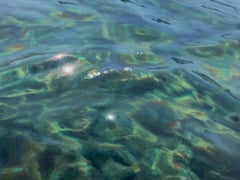Irina Cumberland Clear Lake
Recent Sales
21st Century and Contemporary Photorealist Figurative Paintings
Wood, Oil
21st Century and Contemporary Photorealist Figurative Paintings
Wood, Oil
21st Century and Contemporary Photorealist Figurative Paintings
Wood, Oil
21st Century and Contemporary Photorealist Figurative Paintings
Wood, Oil
Irina Cumberland for sale on 1stDibs
Irina Cumberland specializes in ocean and fractal patterns painting. Irina was born in Ukraine and is currently living and working in the US. Irina has developed a painting style to highlight Natural Fractal Patterns and colors on canvas. Each painting is specifically designed to maximize the calming effects of shapes, colors and scenery. Being medically trained Irina discovered that there was a growing interest in the calming effects of fractal patterns among scientists. A 1986 NASA study demonstrated that participants who viewed images consisting of fractal patterns of nature experienced a 44% decrease in physical stress response. These Fractal Patterns such as snowflakes, trees, and waves repeats itself infinitely across different scales and sizes. This has now become Irina's main focus in Art. Cumberland states, "I watched the ocean’s steady movement in and out, the glittering light dancing on the surface, the tiny rainbows reflecting off the sand – lulling me into a peace that I’d never experienced before. As we have moved away from nature and into skyscrapers and concrete jungles, we have inadvertently removed ourselves from what calms and comforts us, and have instead surrounded ourselves with shapes and images that increase our stress response. This is important, considering that in our culture we are surrounded by such artificial geometric patterns: in our architecture and sometimes in the abstract art we hang on our walls."
A Close Look at photorealist Art
A direct challenge to Abstract Expressionism’s subjectivity and gestural vigor, Photorealism was informed by the Pop predilection for representational imagery, popular iconography and tools, like projectors and airbrushes, borrowed from the worlds of commercial art and design.
Whether gritty or gleaming, the subject matter favored by Photorealists is instantly, if vaguely, familiar. It’s the stuff of yellowing snapshots and fugitive memories. The bland and the garish alike flicker between crystal-clear reality and dreamy illusion, inviting the viewer to contemplate a single moment rather than igniting a story.
The virtues of the “photo” in Photorealist art — infused as they are with dazzling qualities that are easily blurred in reproduction — are as elusive as they are allusive. “Much Photorealist painting has the vacuity of proportion and intent of an idiot-savant, long on look and short on personal timbre,” John Arthur wrote (rather admiringly) in the catalogue essay for Realism/Photorealism, a 1980 exhibition at the Philbrook Museum of Art, in Tulsa, Oklahoma. At its best, Photorealism is a perpetually paused tug-of-war between the sacred and the profane, the general and the specific, the record and the object.
“Robert Bechtle invented Photorealism, in 1963,” says veteran art dealer Louis Meisel. “He took a picture of himself in the mirror with the car outside and then painted it. That was the first one.”
The meaning of the term, which began for Meisel as “a superficial way of defining and promoting a group of painters,” evolved with time, and the core group of Photorealists slowly expanded to include younger artists who traded Rolleiflexes for 60-megapixel cameras, using advanced digital technology to create paintings that transcend the detail of conventional photographs.
On 1stDibs, the collection of Photorealist art includes work by Richard Estes, Ralph Goings, Chuck Close, Audrey Flack, Charles Bell and others.
Finding the Right figurative-paintings for You
Figurative art, as opposed to abstract art, retains features from the observable world in its representational depictions of subject matter. Most commonly, figurative paintings reference and explore the human body, but they can also include landscapes, architecture, plants and animals — all portrayed with realism.
While the oldest figurative art dates back tens of thousands of years to cave wall paintings, figurative works made from observation became especially prominent in the early Renaissance. Artists like Michelangelo, Leonardo da Vinci and other Renaissance masters created naturalistic representations of their subjects.
Pablo Picasso is lauded for laying the foundation for modern figurative art in the 1920s. Although abstracted, this work held a strong connection to representing people and other subjects. Other famous figurative artists include Francis Bacon and Lucian Freud. Figurative art in the 20th century would span such diverse genres as Expressionism, Pop art and Surrealism.
Today, a number of figural artists — such as Sedrick Huckaby, Daisy Patton and Eileen Cooper — are making art that uses the human body as its subject.
Because figurative art represents subjects from the real world, natural colors are common in these paintings. A piece of figurative art can be an exciting starting point for setting a tone and creating a color palette in a room.
Browse an extensive collection of figurative paintings on 1stDibs.

